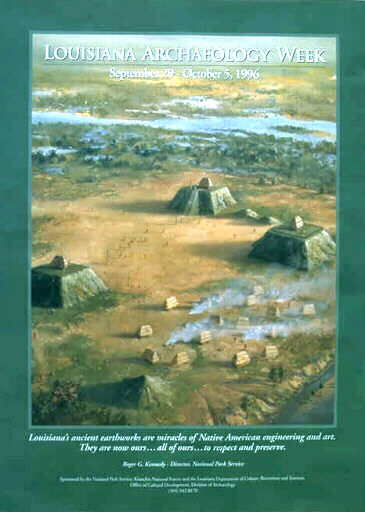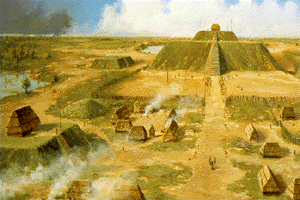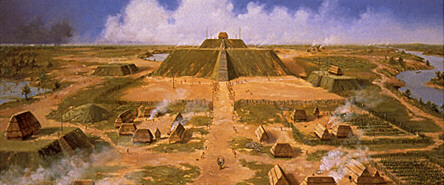 |
 |
NAGPRA: A Lesson in Human Awareness
by Starlight Dances
In the information age, there is an abundance of information available in the 20th Century on a vast variety of subjects. However, one topic with the acronym of NAGPRA has, for the most part, eluded the public spotlight. NAGPRA is short for the Native American Protection and Repatriation Act, a law enacted on November 15, 1990. The purpose of this act is to protect sacred burial sites of the Native American people and to establish some restrictions regarding the removal of human remains, funerary objects, sacred objects, and objects of cultural patrimony that are located on Federal and Native American/Hawaiian lands. NAGPRA also sets the perimeters for the repatriation (return to Native peoples) of various cultural items, upon request. This Act criminalizes the trafficking of those items and sets further regulations for controlling their excavation. Despite serious opposition to NAGPRA, it has proven itself a valuable tool by both redressing the ills forced upon American Indians and providing an avenue of cultural exchange (Tabah, Agnes).
Though many establishments have been affected by NAGPRA perhaps none as much as your local (Federally funded) museum. According to Doris Anthineos of the Antique Monthly, in November 1993, Federally-funded agencies and museums possessed 100,000 to 200,000 Indian human remains and an estimated 10 to 15 million cultural artifacts. To comply with NAGPRA, museums have been forced to compile in-depth categorizations of Native American objects. This has both advanced knowledge of the native people (by the scholastic art world) and caused many extra long work days. The process of completing the NAGPRA inventories (required by all Federally-funded institutions) includes submitting copies of each museum's Native American artifacts to all tribes to which the objects pertain. "This process opens a path for dialogue between the museums and tribal elders, thus deepening our knowledge of Native Americans," says Paul Tarver, the registrar for the New Orleans Museum of Art. The effort of compliance has not been easy due to the vagueness of the law and the labor involved in its conveyance.
 |
Native Americans suffered many injustices at Washington's hand, but in recent years several tribes have won key legal victories establishing tribes' jurisdiction over their land and people (Moore, John). These legal victories have paved the road for NAGPRA and the further Federal recognition of the Native American people. By allowing justice to pertain to all people, not only the elite, the Federal government has begun the process of healing a heinous wrong. Of course, not all people view NAGPRA in such a positive light. Bill Day, curator for the Tunica-Biloxi Museum (Marksville, LA) stated that, "In almost every area the law was filled with vague loopholes." Granted, there are areas that could be improved upon. Ambiguous language and not enough adequate guidance seem to be the major complaints of those who are affected by NAGPRA. The terms "cultural items," "sacred objects," and "cultural patrimony" have different meanings to each band of native people. For example, what is good medicine for one tribe is not necessarily good medicine for all tribes.
 |
At the core of the issue is a moral dilemma pondered by most scholars -- is the quest for knowledge more important than the sacred traditions of a people? Usually, answers to this question still vary widely, but most people would not care to have their favorite relatives interred for any reason. There are many ceremonies to mark the end of a person's existence. Burial is the choice of many. It is a most fitting repose, returning to give substance to the ground that has given you a lifetime of sustenance. Most cultures have no ritual for the re-burial of their loved ones who were unearthed without the consent of their heirs. NAGPRA attempts to address the problems that an entire nation of people have faced and adjust the scales to a more equal range. There can be no atonement great enough for many of the past wrongs inflicted on the Native American people, but there can be a healing of the wounds. With the passing of time, often scars soften.
 |
The overall societal impact of NAGPRA is further reaching than surface images might indicate. An abstract written by Rob Bonnichsen from Oregon State University in June of 1995 laments NAGPRA, as he was asked to surrender ancient hair found at a Montana burial site. This archaeologist is quite sure the age of mankind could be ascertained by studying DNA samples of the hair.
All anthropological groups must now obtain a permit and the consent of the appropriate Indian tribe before excavating a site (Public Law 101-601). The safeguard of permits prevents looters from tampering with native grave sites. The activities of construction, mining, logging and agriculture are given instructions within the NAGPRA subheading of "Inadvertent Discovery of Native American Remains and Objects." As you see, NAGPRA is not only a tribal concern, it influences the behavior of farmers, miners, architects, lumberjacks, anthropologists, archaeologists, curators, art dealers, collectors, and historians, as well as Native Americans.
The pursuit of research information regarding the Native American Grave Protection and Repatriation Act has been a very nettlesome task. It seems as though all aspects of Native American issues have been overlooked by American society. In the course of this work I have encountered no front page headlines or television clips, a vacuum with regard to the plight of the native people of this fair country. The obfuscation that began long ago before the Constitution was enacted still exists today. People tend to avoid that which they are ashamed of, be it the treatment of those who have no place to live or those who have had their final resting places disturbed.
However, regarding the issue of NAGPRA, Greyhawk (a friend of mine) had the best philosophy, "Some restitution is better than none at all."
Starlight Dances
November 20, 1996
 |
Works Cited
Athineos, Doris, "Tribal Art Law: A Time to Return," Antique Monthly, November 1993, pp. 27-30.
Day , Bill, personal interview, October 11, 1996.
Native American Graves Protection and Repatriation Act, Westlaw: USCA Legal Teaching Tool, WL 496382, pp. 1-19, October 14, 1996.
Perkins, Greyhawk, personal interview, October 16, 1996.
Tabah, Agnes, "Native American Collections and Repatriation," American Association of Museums Technical Information Service Forum, September 19, 1992.
Tarver, Paul, personal interview, October 4, 1996.
Native American Graves Protection and Repatriation Act, 101st Congress, Washington, D.C.: approved November 16, 1990.
For additional information, try here:
Native American Anthropology and Archaeology Links
| Starlight's Studio: | Who is Starlight Dances? | Teas, Incense & Other Recipes | The Wheel of the Year | Phases of the Moon | Starlight on NAGPRA | The Church of Culture | Magickal Herbalism 101 | Intro to Color Magick | Correspondence Charts | A Horticultural Grimoire | In the Studio with Star |
| Greybeard's Garage: | Who is Greybeard Dances? | Paganism 101 | A Question of Definitions | Paganus: Another Perspective | Responsible Pagan Authorship | Monotheists Anonymous | Greybeard's Poetry | Muses & Mystics | A Shrine to Pan | Recommended Reading | Radical Druidry |
| Mirthful Paths: | The Mirthful E-List | Our Award Winners | Word/Riddle of the Day | The Whole Pagan Webring | Survivor III: Swamp Casting |
| Links & More Links: | Reciprocal Sites | Pagan Organizations | Pagan Authors | Web Rings | Banner Exchanges |
| About This Site: | Sign Our Guestbook | View Our Guestbook | What's New? | Awards We've Won | Site Credits | Contact Us |
All site contents, unless otherwise noted, are the copywritten property of Starlight and Greybeard Dances, and may not be borrowed, used, quoted or otherwise distributed in their entirety or in any part without express written permission. Questions or comments on this site may be directed to either Starlight or Greybeard.
This site last updated: 21 Aug 2003 12:05 PM -0500